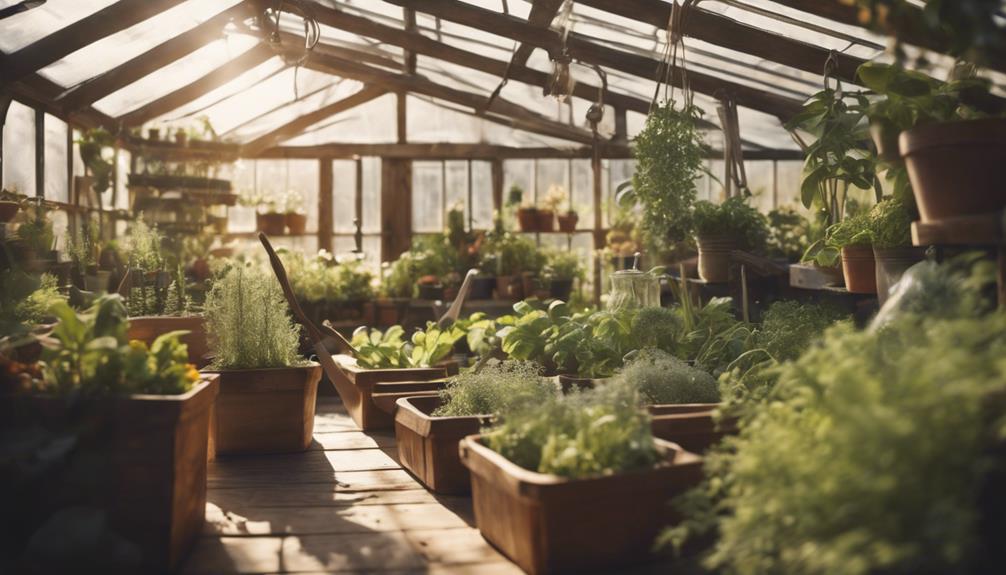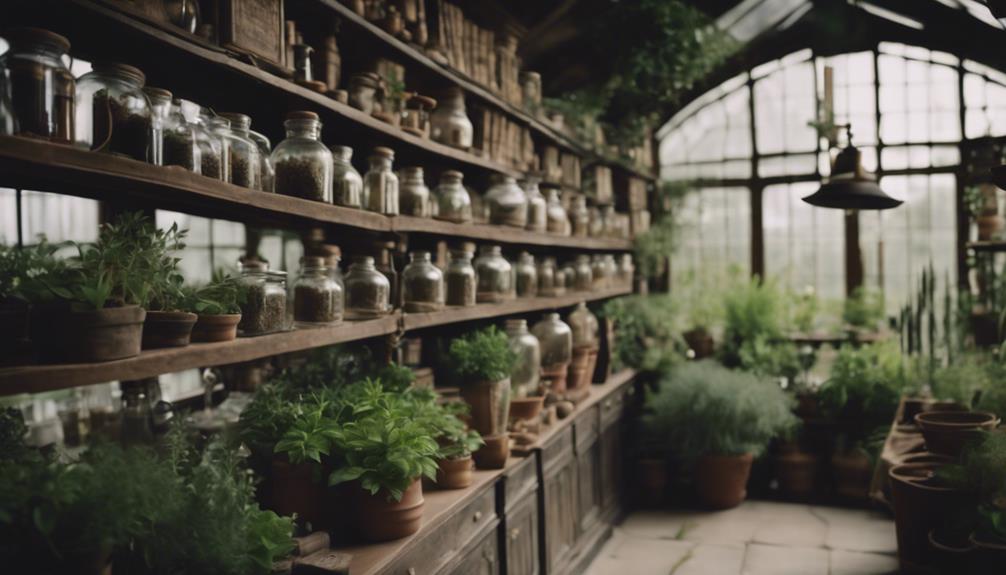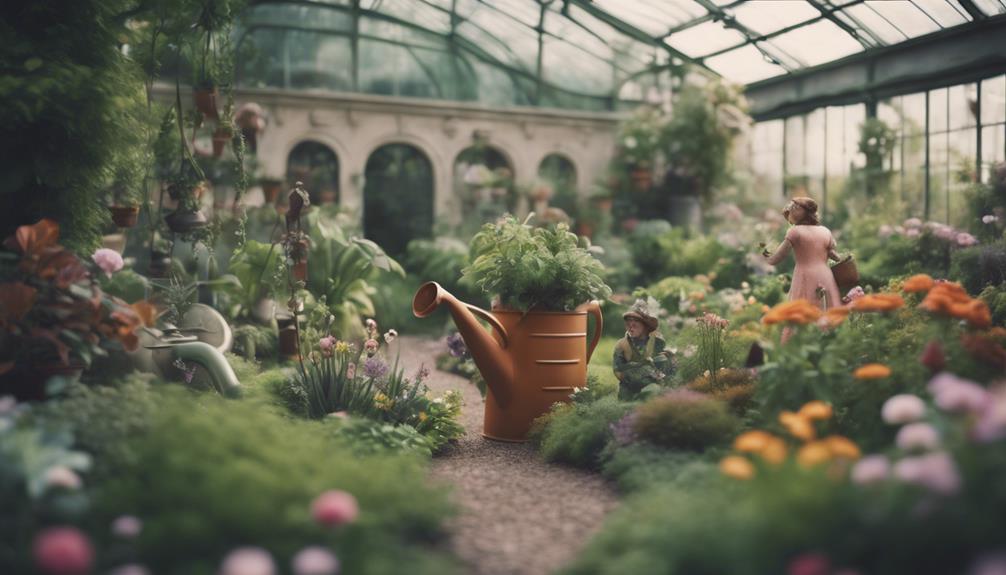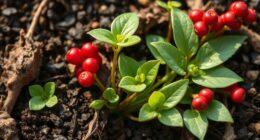We pinpoint Silphium, a plant species that dates back to ancient times, as the oldest herb in the world, boasting a rich history of medicinal, culinary, and symbolic significance across various civilizations. From its rumored contraceptive effects to its use in culinary dishes and as currency in trade, Silphium's historical significance is undeniable. Featured on coins and praised by prominent physicians, Silphium's versatility and importance are evident. As we explore the intricate relationships between nature, medicine, and human experience, we uncover the fascinating story of Silphium, a true ancient wonder, and discover why it remains an enduring symbol of fertility, prosperity, and good health.
Key Takeaways
• Silphium is considered one of the oldest herbs in the world, with historical records dating back to ancient Greece and Rome.
• Artemisia, also known as wormwood, has been used in traditional Chinese medicine for thousands of years, treating various ailments like fever and rheumatism.
• Henbane, a plant with powerful hallucinogenic properties, has been used in magic, ritual, and medicine for centuries, with ancient roots in European folklore.
• Datura, another plant with hallucinogenic properties, has been used in rituals, medicine, and as a poison, with a history dating back to ancient India and Europe.
• Wolfsbane, a plant historically used in battles, executions, and spells, has been revered for its medicinal properties and ancient remedies, with a long history in European folklore.
Ancient Roots of Magical Plants
As we explore the mystical world of magical plants, we find ourselves surrounded by ancient botanical wonders that have been revered and feared for centuries. These enigmatic species have been woven into the fabric of human history, serving multifaceted purposes that transcend the domain of mere botany.
In the domain of medicine, for instance, we find plants like Henbane, whose alkaloids have induced powerful hallucinations, and Datura, capable of producing spiritual journeys or trances. We also discover Artemisia, an herb linked to powerful women, used in magic, ritual, and medicine to lure love, cleanse, protect, and divine.
Even Wolfsbane, with its toxic aconitine, has been utilized historically in battles, executions, and spells to ward off supernatural entities. As we explore further, we realize that these plants have been revered for their medicinal properties, holding the secrets to ancient remedies and mystical practices.
As we uncover the mysteries of these magical plants, we begin to appreciate the intricate dance between nature, medicine, and the human experience.
History of Ritual and Medicine

We've only scratched the surface of the mystical world of magical plants, and now we're ready to explore how ancient civilizations harnessed their power in rituals and medicine. Silphium, the oldest herb in the world, held a revered position in ancient societies, and its significance extends beyond its medicinal properties.
In ancient rituals, Silphium played an essential role in ceremonies, symbolizing fertility, prosperity, and good health. Its culinary uses were equally valued, as it added flavor to dishes and was used as a form of currency in trade. Here are some ways Silphium was utilized:
- Medicinal properties: Silphium was prized for its ability to cure ailments, from indigestion to respiratory issues.
- Contraceptive effects: The herb was rumored to have contraceptive properties, making it a sought-after commodity.
- Culinary uses: Silphium added flavor to dishes and was used as a form of currency in trade, showcasing its cultural and economic importance.
Its significance is evident in historical texts and on coins from regions like Kyrenaika, demonstrating the herb's cultural and economic importance.
Mystical Properties of Artemisia

As we explore the mystical properties of Artemisia, we'll uncover the ancient medicinal uses of these plants, which have been employed for centuries to treat various ailments.
We'll also examine the spiritual significance of Artemisia, which has been revered for its mystical powers and ability to harness the unknown.
From luring love to cleansing and protection, we'll discover how Artemisia has been utilized for a multitude of mystical purposes.
Ancient Medicinal Uses
From ancient rituals to modern medicine, we've explored Artemisia's mystical properties to treat ailments, harness its magical powers, and tap into its hallucinogenic effects. As we investigate the ancient medicinal uses of Artemisia, we find that its significance transcends cultures and centuries.
In Chinese medicine, Artemisia was used to treat fever, rheumatism, and menstrual issues. Its versatility is evident in its application in various forms, including teas, infusions, and tinctures.
Here are some examples of Artemisia's medicinal uses:
- Antipyretic properties: Artemisia has been used to reduce fever and alleviate symptoms of malaria.
- Digestive aid: Its bitter properties have been utilized to stimulate digestion and relieve indigestion.
- Women's health: Artemisia has been employed to treat menstrual cramps, regulate periods, and aid in childbirth.
The diverse uses of Artemisia in medicine highlight its enduring presence throughout history.
As we continue to uncover the secrets of this ancient herb, we're reminded of its profound impact on human health and well-being.
Spiritual Significance Unveiled
Exploring its medicinal applications, Artemisia's mystical properties have captivated cultures worldwide, earning it a revered position in spiritual practices and magical rituals. We've uncovered that this ancient herb is deeply rooted in folklore and traditional healing, with references dating back to ancient civilizations. Its association with powerful women and spiritual practices has contributed to its rich history.
We've found that Artemisia is utilized for various purposes, including luring love, cleansing rituals, protection from negative energies, and divination in different cultural contexts. The presence of thujone, a compound with potential hallucinogenic properties, adds to the plant's mystical allure and spiritual significance.
As we investigate further into the mystical properties of Artemisia, we're struck by its diverse applications in magical practices, making it a fascinating subject of study in herbalism, folklore, and esoteric traditions. Its spiritual significance is undeniable, and we're enthusiastic to explore its mystical powers further.
Mystical Powers Harnessed
We investigate the mystical powers of Artemisia, uncovering the secrets behind its hallucinogenic properties and diverse magical applications. As we explore the mystical properties of this ancient herb, we discover its association with powerful women and its use in magic, rituals, and medicine for centuries.
Artemisia plants have been utilized for purposes such as:
- Luring love through spells and incantations
- Cleansing rituals to purify the mind and body
- Protection spells to ward off negative energies
Certain species of Artemisia, like wormwood and mugwort, contain thujone, a compound known for its potential hallucinogenic effects in high concentrations. These mystical properties have led to the herb's enduring presence in folklore and herbal traditions.
As we harness the mystical powers of Artemisia, we uncover a rich history of magical applications, from divination practices to spiritual rituals. By understanding the mystical properties of Artemisia, we gain insight into the ancient cultures that revered this herb and its significance in shaping our understanding of magic and medicine.
Thujone and Its Hallucinogenic Effects
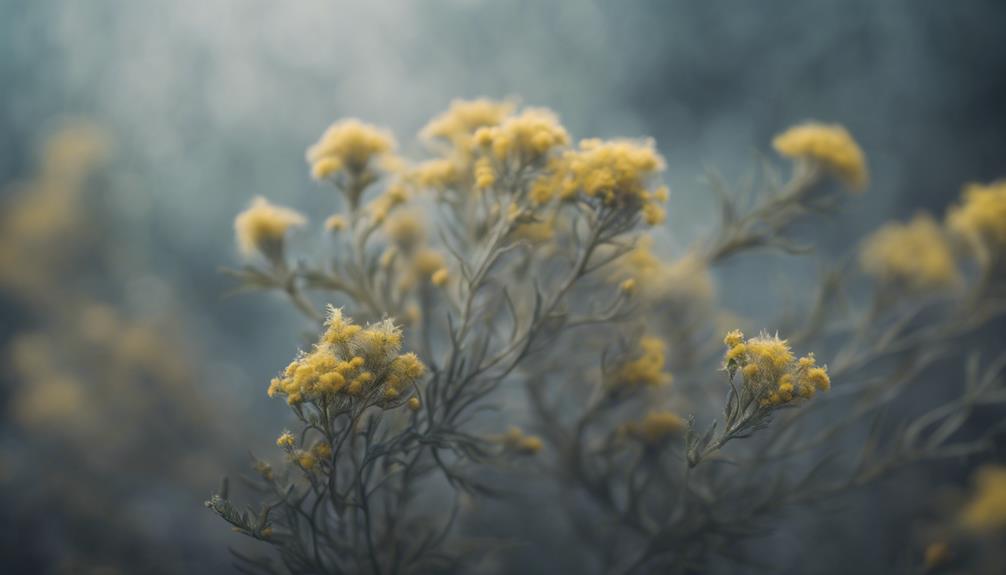
As we explore the enigmatic world of thujone, it becomes increasingly clear that this potent chemical compound has captivated human imagination for centuries.
Thujone, a chemical compound found in various plants, including wormwood and mugwort, is renowned for its hallucinogenic properties. The hallucinogenic effects of thujone are attributed to its ability to act on the GABA receptors in the brain, leading to altered perceptions.
When consumed in high doses, thujone can induce visual and auditory hallucinations, making it a substance of interest in magic, ritual, and medicinal practices. Some cultures believed that thujone-containing plants like wormwood had the power to enhance divination, protection, and spiritual experiences.
However, thujone's hallucinogenic nature has also led to cautionary measures due to its potential toxic effects when consumed in large quantities.
As we investigate further into the world of thujone, we begin to appreciate the complex and multifaceted nature of this chemical compound.
Ancient Civilizations and Uses
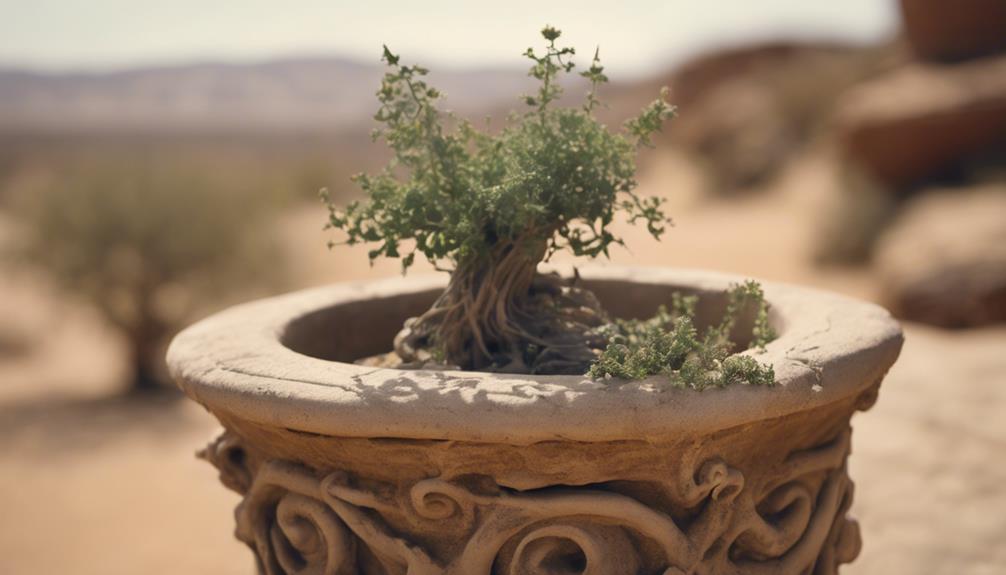
One of the most fascinating aspects of ancient civilizations is the reverence with which they regarded certain herbs, none more so than silphium, a plant so prized that its image adorned coins and its uses were extolled by prominent physicians and philosophers. We find it intriguing that silphium held such significance in ancient societies, particularly among the Greeks and Romans.
Silphium's versatility is evident in its various uses, including:
- Culinary purposes: Silphium was used as a spice and flavoring agent, adding depth to dishes.
- Medicinal applications: The herb was employed to treat various ailments, showcasing its perceived medicinal value.
- Birth control: There's evidence suggesting silphium was used for contraception, highlighting its importance in ancient daily life.
As we explore further into ancient civilizations, we discover that silphium's significance extends beyond its practical uses. Its image on coins and references in ancient texts, such as those by Theophrastus and Hippocrates, demonstrate its cultural and economic importance.
Silphium's legacy continues to captivate historians and botanists alike, sparking ongoing research into its uses and significance.
Powerful Women and Magical Associations

In the domain of ancient magical practices, plants like wormwood and mugwort, belonging to the Artemisia genus, have long been associated with powerful women, who harnessed their mystical properties to lure love, cleanse, protect, and divine. These women, often revered as healers, spiritual guides, and sorceresses, employed Artemisia in their magical, ritualistic, and medicinal practices. The plants' properties, including their hallucinogenic effects from thujone, made them valuable assets in mystical pursuits.
| Cultural Significance | Magical Associations | Ritualistic Uses |
|---|---|---|
| Folklore and Herbalism | Luring Love, Cleansing | Meditation, Divination |
| Spiritual Beliefs | Protection, Divination | Purification Rites |
| Ancient Civilizations | Mystical Properties | Shamanic Practices |
We find that the use of Artemisia in magical practices reflects its significance in folklore, herbalism, and spiritual beliefs. As we explore further into the world of magical associations, we begin to appreciate the power and mystique surrounding these ancient plants.
Cleansing, Protection, and Divination

As we explore the mystical domain of Artemisia, we find ourselves drawn to the domain of cleansing, protection, and divination, where the herb's properties are leveraged to purify the air and ward off evil spirits.
Through the ages, practitioners have utilized Artemisia to create potent potions and charms, harnessing its cleansing properties to banish negative energies and attract positivity.
Purify the Air Now
We can explore the potent cleansing properties of Artemisia to purify the air around us, creating a sacred space for spiritual growth and mystical exploration.
As we investigate the ancient magic of Artemisia, we find that these sacred plants have been used for centuries to cleanse and protect spaces. The National Library archives are filled with tales of mystical rituals and ceremonies that utilized Artemisia for purification and divination.
Here are three ways we can utilize Artemisia to purify the air:
- Smudging: Burn dried Artemisia leaves to release the cleansing properties, driving out negative energies and inviting positivity.
- Incense: Mix Artemisia with other herbs to create a purifying incense, perfect for meditation and spiritual practices.
- Potted Plants: Keep potted Artemisia plants in your space to naturally purify the air and create a calming atmosphere.
Ward Off Evil Spirits
Let's tap into the mystical powers of Artemisia to ward off evil spirits, harnessing its ancient magic for cleansing, protection, and divination. As we explore the mystical world, we discover the herb's protective properties, which have been utilized in various rituals throughout history. From luring love to cleansing spaces, Artemisia's versatility is undeniable.
| Ritualistic Use | Purpose |
|---|---|
| Love Spells | Attracting positive relationships |
| Space Cleansing | Purifying environments from negative energy |
| Protection Rituals | Warding off evil spirits and negative influences |
| Divination Practices | Enhancing intuition and psychic abilities |
| Spiritual Practices | Connecting with the divine and higher self |
Artemisia's presence in these rituals highlights its enduring role in various cultural practices and beliefs. The herb's ancient magical associations, coupled with its hallucinogenic properties, make it a potent tool for those seeking spiritual growth and protection. As we explore the mystical powers of Artemisia, we find ourselves drawn to its protective properties, which have been revered for centuries.
Luring Love and Mystical Practices

In our exploration of Artemisia's mystical properties, we find that these ancient plants have long been associated with luring love and mystical practices, with their potent essences and hallucinogenic compounds believed to spark passion and reveal hidden truths.
As we investigate further, we discover that Artemisia has been used in various rituals to attract love, foster intimacy, and ignite passion.
Some of the ways Artemisia has been utilized in mystical practices include:
- Love potions: Artemisia's potent essences were believed to spark passion and attract love.
- Cleansing rituals: The plant was used to cleanse and purify the body and mind, preparing individuals for mystical experiences.
- Divination practices: Artemisia's hallucinogenic compounds were used to reveal hidden truths and gain insight into the unknown.
It's no wonder that Artemisia has been a staple in mystical practices throughout history, particularly among powerful women who sought to harness its mystical powers.
As we continue to uncover the secrets of this ancient herb, we're reminded of the enduring allure of Artemisia in the domain of mystical practices.
Enduring Reputation Throughout History

Silphium, the ancient herb, has explored its enduring reputation throughout history, earning it a coveted spot as one of the oldest and most renowned herbs in the world.
We've uncovered a long history of silphium's significance, dating back to ancient times when it was highly valued for its diverse uses, including medicinal, culinary, and possibly even as a form of birth control. References to silphium can be found in ancient texts like those of Theophrastus, Hippocrates, and on coins from regions like Kyrenaika, showcasing its widespread importance in ancient societies.
Silphium's cultural and economic significance in regions like Kyrenaika is particularly notable, reflecting its importance in the daily lives of ancient people.
Through ongoing research and conservation efforts, we're reminded of silphium's enduring legacy and significance in the history of herbal medicine.
As we investigate further into silphium's past, we're struck by the herb's remarkable staying power, earning it a permanent place in the annals of history.
Frequently Asked Questions
What Is the Oldest Herb?
We're curious about the oldest herb, wondering which one takes the title. After digging in, we found that silphium, an ancient plant, is believed to be the oldest, with a rich history in ancient civilizations like Greece and Rome.
What Is the Oldest Known Medicinal Plant?
As we explore the world of ancient remedies, we uncover Silphium, a symbol of enduring legacy, whose significance extends beyond its medicinal properties, representing a rich cultural heritage that transcends time, and we find it's the oldest known medicinal plant.
What Is the Most Powerful Herb in the World?
We're curious about the most powerful herb in the world, considering its potential impact on our well-being. We've heard whispers of Ashwagandha, Turmeric, and Ginseng, but we're still unsure which one takes the crown.
Which Herb Is the King of Herbs?
We're wondering which herb earns the "King of Herbs" title, and after some digging, we found that Silphium, an ancient, versatile herb, was dubbed the "King of Herbs" due to its numerous culinary, medicinal, and cultural uses.
Conclusion
As we unravel the mysteries of Artemisia, we find ourselves entwined in a rich tapestry of ancient civilizations, mystical associations, and medicinal properties.
This herb, touted as the oldest in the world, has traversed the boundaries of time, weaving a narrative of ritual, medicine, and mystique.
From ancient Greece to modern-day practices, Artemisia's hallucinogenic properties and cleansing powers have captivated our imagination, solidifying its enduring reputation as a potent and enigmatic herb.
As we reflect on its storied past, we're reminded that, indeed, 'the secrets of the past are the keys to the future.'


